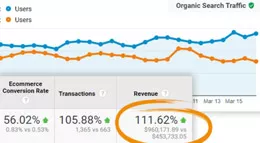Page Speed and Decreased Conversion Rates: 2023 Statistics
How much of a priority is page speed within your organization? If you’re like most companies, you want a fast website, but you also have a whole other list of projects clogging up your backlog. However, you may want to bump your page speed improvements up your priority list. Visitors are significantly impacted by your slow website – but you have the power to turn it around and grow your sales by creating a positive experience for them.
Check out the latest statistics on page speed and conversion rates, updated for 2023, so you can see just how unforgiving internet users are when it comes to a slow website.

Website Operating at Acceptable Page Speed
Page speed continues to be critical for user experience. According to WebsiteBuilderExpert.com, it was found that for e-commerce sites, a one-second page delay could potentially cost $2.5 million in lost sales per year for a site making $100,000 per day. Additionally, the use of Accelerated Mobile Pages (AMP) by some site owners has been noted as a way to improve mobile page speeds.
Image via Unbounce.
Visitor Bounce Rates
The bounce rate significantly increases with longer page load times. For example, a 0.1-second improvement in site speed on mobile devices can enhance conversions by 8.4%. It’s also reported that every additional third-party script on a website can slow it down by about 34.1 milliseconds.
Image via Pingdom.
Impact on Purchasing Decisions
Site speed continues to be a crucial factor in customer purchasing decisions. Nearly half of all customers (46%) reported they would never revisit a website with poor loading times. Furthermore, a one-second delay in your page load time may decrease customer satisfaction by 16%, and 64% of customers who have a bad experience are less likely to return.
Delay in Page Load and Conversion Rates
A delay in page loading significantly affects conversions. Conversions decrease by 7% for each second of delay. The highest conversion rates are observed on websites that load within two seconds.
SEO and UX Signals
Page speed continues to be a crucial factor for SEO. Studies show that bounce rates increase by 32% when the loading time increases from 1 to 3 seconds and by 90% when loading times rise from 1 to 5 seconds. Additionally, three-quarters of the user experience signals used by SEO are linked to website page speed.
Image via Social Media Explorer.
Website Size and Speed
Large website pages (>3.49 MB) take significantly longer to load compared to smaller pages (<0.83 MB). This highlights the importance of optimizing page size for better performance.
Image Compression for Website Size Reduction
Compressing images and text can lead to substantial savings in website size and improve loading times. It’s estimated that about a quarter of web pages could save 250KB, and 10% could save 1MB or more by optimizing images and text.
Marketers and Customer Lifetime Value Monitoring
Only 24% of marketers believe their companies effectively manage the lifetime value of their customers. This reflects an ongoing challenge in aligning marketing strategies with long-term customer engagement and retention.
Image via Criteo.
User Experience Should be at the Forefront of Your Marketing Plan
Some back-end changes don’t seem to have a direct, immediate impact on sales. However, your page speed improvement is not one of them. These statistics point to a direct correlation between a slow website and annoyed customers who bounce and never buy. If your conversion rate isn’t what you expect it should be, then you need a site speed audit and a plan for improvement, and KodingWeb can help. Reach out to our team to talk about your website. Let’s develop a plan of attack to increase your conversion rate and maximize your business opportunity.






